Rosa Stromeyer – a window into Rewley House's past

In the summer of 2016, Oxford resident Toby Milner walked into Rewley House on a family history quest. He brought extraordinary news.
‘My great-grandmother, Rosa Stromeyer, taught here in 1883-4,’ he said, adding, ‘and she kept a diary and drew pictures of the place during her time.’
Given the dates Toby mentioned, it was clear that Rosa hadn’t been a tutor on Oxford’s Continuing Education programme. The Department's work was begun in 1878 and took place in towns and cities all over England. It wasn't until 1927 that we acquired Rewley House.
St Anne’s Rewley
Rosa taught at the St Anne’s Rewley School, a boarding school for girls. Rewley House was purpose-built for the school in 1873. The school was part of the parish of St Thomas, and was connected to the church of St Thomas the Martyr – a church of the Anglo-Catholic tradition. The school, which was run by nuns, operated at Number 7 in the south east corner of Wellington Square from 1873 until it moved to larger premises in 1904.
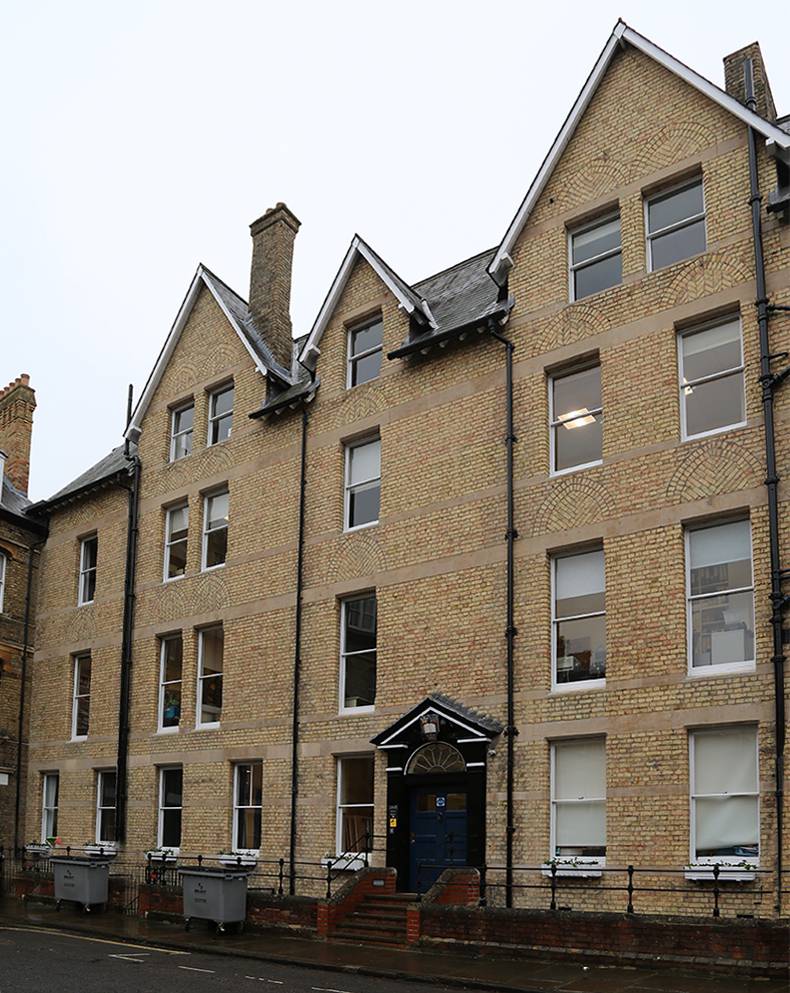
Rewley House occupies the southeast corner of Wellington Square and was originally built to house the St Anne's Rewley School in 1873.
‘Rosa was one of ten children,’ Toby told us, ‘and when her father’s business interests suffered in the early 1880s, she and her sisters were gently urged either to get married or to get jobs.’
Rosa arrived at St Anne’s Rewley in January 1883, to teach German and music.
'In researching my family history,' said Toby, 'it was a surprise to find that my great-grandmother had lived in Oxford and to be able to locate the rooms in Rewley House where she had stayed and worked over 130 years ago.'
From the point of view of this Department, Toby's discovery of Rosa's former place of employment was even more surprising. Through the diary she kept and the drawings she made between 1883 and 1884, Rosa Stromeyer would open our eyes to an earlier world of education, one that we knew very little about.
Life on Wellington Square in 1883
Census records from the late 19C tell us that some of the school’s boarders were girls from families based in far-flung parts of the British Empire, such as South Africa and India. A sizable number of girls came from Liverpool. In addition to these was the occasional waif. The Oxford Board of Guardians Reports, 1883–1890 lists: 'Sarah Dash, aged 13; deserted child. Address - Rewley House. Parish - Saint Thomas. Out-door poor'.
St Anne’s Rewley was attached to the high Anglican church of St Thomas, in central Oxford. The school took its name from a famous seat of learning, Rewley Abbey, a Cistercian monastery, founded in the 13th century. Rewley Abbey stood just east of the current Oxford rail station.
Because St Thomas’s was high Anglican, church services were a prominent in the day-to-day schedule. As Rosa records in her very first diary entry, it was a dull existence for a young woman from a large London family.
March 21st 1883
A short account of how Lent and Easter is spent at Rewley. Strange to me of course. All Lent-time no pleasures, or any gaiety. Wednesday & Friday, no meat for meals, except the governesses in the evening: also silence at breakfast & dinner…early celebration at 8 o'clock, church at eleven, children church-going at 3 o'clock & evening service at 7 o'clock. I am supposed to go to 8, 11 & 7 o'clock services, unless I am not well…Throughout the year Friday no meat at breakfast & silence at the breakfast & dinner.
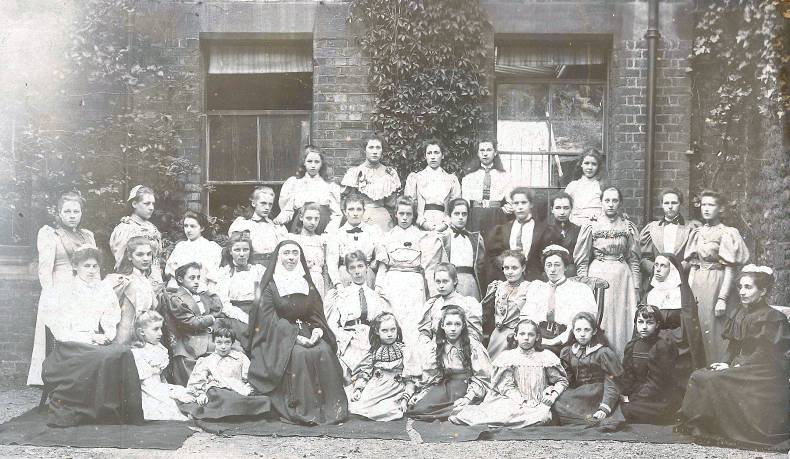
St Anne’s Rewley group photo, circa 1895 – about ten years after Rosa’s time, and ten years before the school moved to larger premises.
Meals at St Anne's Rewley were often taken in silence, and the food was somewhat uninspired. A simple meal of bread and butter was quite common – though some meals were more interesting. Foods that Rosa thought worthy of a mention in her journal included macaroni or suet pudding, cold or roast beef, potatoes and cold rice, blanc-mange and syrup, cold mutton, boiled potatoes, beet-root and hominy pudding, Irish stew, roly-poly currant pudding, fried plaice, and milk and sugar pudding.
It’s safe to say that meals served today at Rewley House are more imaginative and nutritious!
Free time
Though Rosa appears to have been on call most of the day, she did manage to get some time to herself. She enjoyed practicing her piano, reading, drawing, crochet and walking – all of which were popular pastimes for a middle-class girl of the time. We know from her diary that Rosa visited some of Oxford’s colleges and the Cathedral at Christ Church.
Friday Feb 29, 1884 - 38th day in Lent
Practised before breakfast one hour. Gave a German class at nine, then two hrs music lesson, crochet instead of taking my own little walk because it rained. Had dinner, hot mutton, mashed potato & ginger syrup suet pudding, took Charge one hr in the school room, gave two hrs music lesson, had tea, again practised nearly an hour and a half, which I always enjoy immensely. Then did what I liked till eight, had supper bread & butter cold mutton & milk. Had Compline & during Lent we always sing at the same time the 51 Psalm. Then did what I liked till 10, went to bed.
Drawing her life
Rosa drew sketches of her surroundings, many of which have survived. Some are views of places Rosa enjoyed in Oxford; most are of her environments at the school. These tell us much about how the old school was configured.
April 7 '84
… I sat in Patience dreaming of the future, & was trying to count how many church and college steeples I could see, I think about 13, perhaps I shall make a sketch of them all tomorrow…
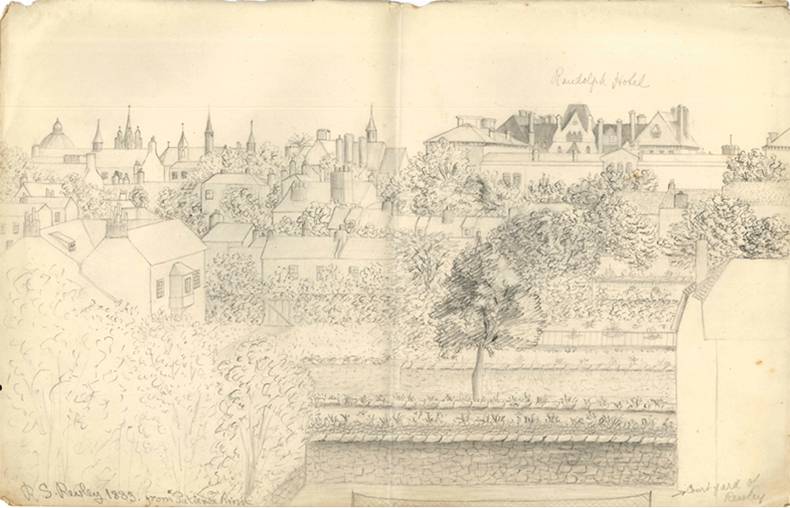
Rosa's view: "From 'Patience Room'"
We’re not sure why the ‘Patience Room’ was thus named, but we can tell from Rosa’s skillful rendering that she was sitting on the top floor of the eastern side of our building, looking south. The roof of the Ashmolean is pictured, and the Randolph Hotel is clearly labelled. This view is much changed today, due to trees which obscure the the towers from view, and also due to new buildings having been added to the landscape. The new wing of the Ashmolean, the new accommodation block at St Cross and the Sackler library are all prominent in this view today, and the Randolph is less so.
We can tell Rosa's exact location from the excellent detail and perspective in her drawing. What she knew as the Patience Room is our boiler room today. It's a small, top-floor room that would have had a small fireplace. (In the drawing below, it is the top-floor window in the dormer in the upper right of the picture.) The ceiling beams remain unchanged since Rosa’s time. This lovely view south is obscured today by a ventillation grille.
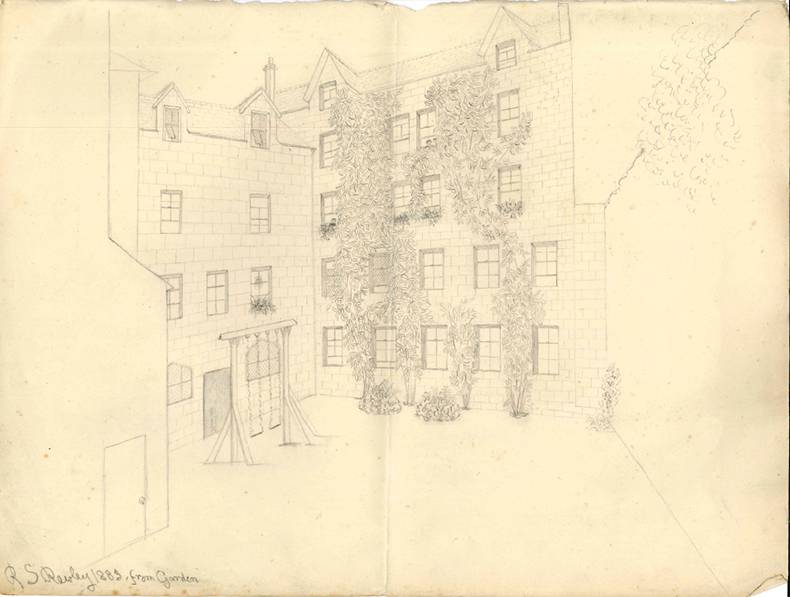
Rosa's view: "from garden"
Rosa was standing in the far corner of what is, today, our Acland Room, looking northwest. In her day, this space was a garden. Notice the swings in the middle left of the drawing - the exterior doors just behind them are doors we currently use to access our main dining room at Rewley House. (The leaded glass windows on either side of these doors are still visible and are attractive features in today's dining room.) The high wall to the right separates the school yard from the old 'paupers' graveyard for Oxford's House of Industry (poor house) which had stood on this site from the 1770s until its demolition in the mid-19th century, prior to the creation of Wellington Square.
If you look carefully, you can see children in the windows on the second and third floors!
The ground floor windows in the sketch above (the windows with vines growing up between them) look out from the girls' refectory, pictured below.
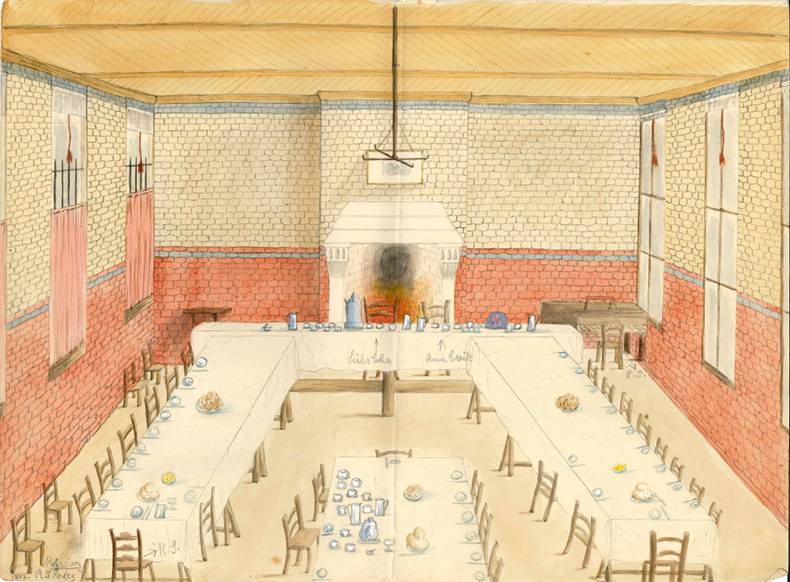
Rosa's view: "Refectory"
From the ceiling and the area railings, which Rosa faithfully records, we know that this room was where the Rewley House kitchen is today. Note that Rosa has labelled the nuns’ seats, and her own two chairs, one in the lower left, and the other at the piano.
Below is the same room in 1927, when Oxford's Department for Continuing Education was given the building. Note how identifiable the fireplace and ceiling are, both beautifully recorded in Rosa's sketch of more than 40 years earlier. (This room is identical in layout to our current Tawney Room, which sits one floor above.)
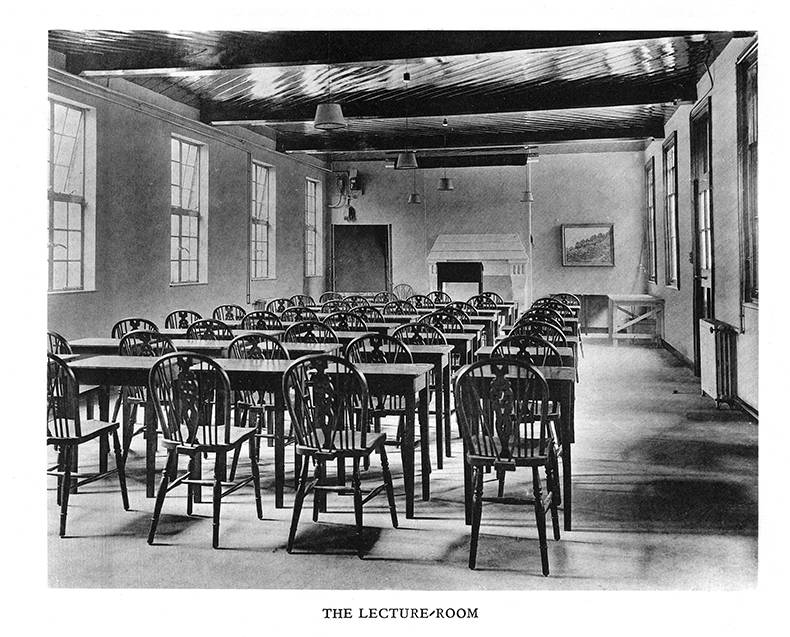
Above: Lecture Room, 1927 - formerly the refectory of St Anne's Rewley School
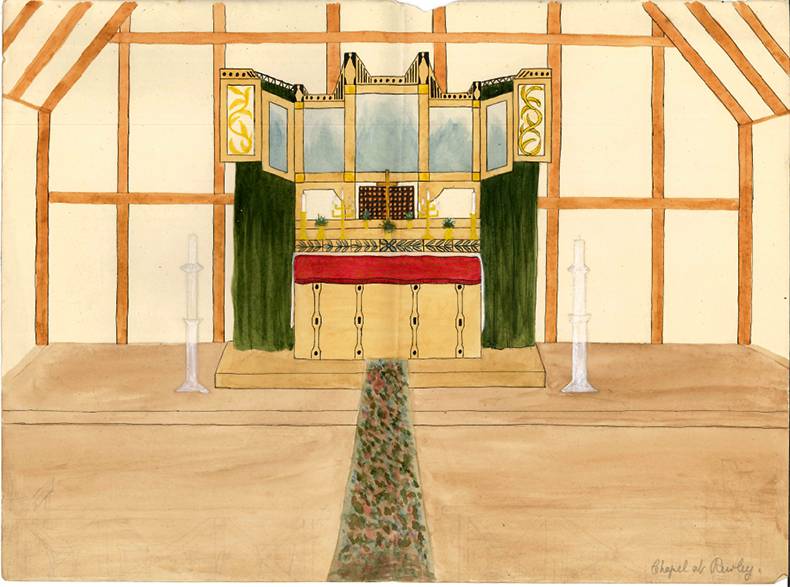
Rosa's view: "Chapel at Rewley"
The school’s chapel was located on the top floor of the old school building, and its impressive doorway can still be seen on the stairs near the Tawney room. From the arrangement of the beams which Rosa has recorded, we are fairly certain that this altar stood against a southern wall that has since been removed. (We assume the school took the altar with them when they moved.) If you look closely, you can just see some pencilled-in altar rails which Rosa evidently decided not to include in her watercolour.
The picture below shows this space in 1927, when the Department acquired the building. The large beam visible in the foreground at the ceiling may mark the place where the chapel's altar used to stand, and where a wall was removed. Note the smaller beams on the ceiling in Rosa's sketch of the chapel, above, and in this photograph. This space is now used by our Personnel office and Registry.

Above: the common room, 1927 - formerly the chapel of St Anne's Rewley School
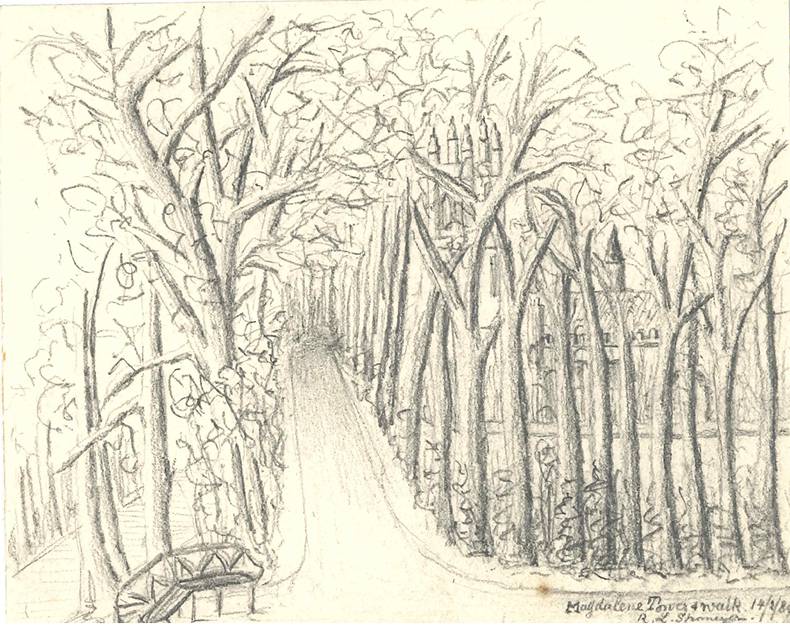
Rosa's view: "Magdalen Tower & Walk"
Rosa most likely made this drawing from somewhere in the Botanical Gardens.
How did Rosa’s story end?
Jan. 27th 1884
…I am going to leave Rewley at Easter & am most likely going to live with my twin. She & Rich. wished me to come, I going on condition that they will let me earn my money there, which they have agreed to. I am of course over delighted to go, & can hardly wait for the time to come…
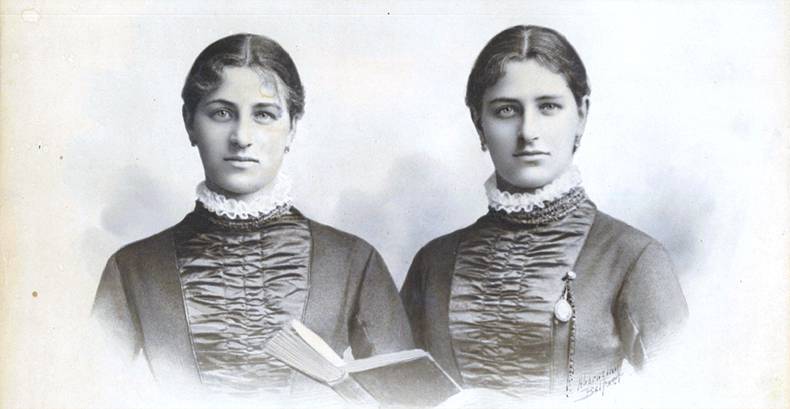
Blanche (left) and Rosa Stromeyer (right), twins, were two of a family of ten siblings.
Rosa was close to her twin sister Blanche and there are many fond references to her in the diary. It’s not clear if she did go live with sister; but we know that Rosa stayed at St Anne’s Rewley for just over a year, leaving in the spring of 1884. She was married in June, 1886, and moved with her husband to Cheshire, where her husband had a successful business, and was an early partner in what would (much later) become the British chemicals conglomerate ICI. She had four sons and a happy marriage.
Of his great grandmother, Toby Milner said, 'Rosa was the daughter of a German merchant working in London and was known to be a very strong-willed, intelligent, and determined woman who, after leaving Oxford, came to manage a substantial household, supported her husband in his business ventures, and eventually outlived him by almost 40 years. I feel sure that she would have been an excellent teacher of Music and German; but equally certain that she would have chafed at the confines of the 19th century church School environment. I feel she would have greatly enjoyed the broader educational experience offered in Rewley House today!'
Rosa lived well into the 20th century, passing away in 1949 at the age of 90.
Rosa's memory endures
Those of us who work and study at Rewley House today have a new dimension layered onto familiar surroundings, thanks to Rosa’s drawings and her journal. Her sketches have prompted staff members to re-examine our building and its configuration. We are more aware of indications in our interior brickwork which show doorways that existed in Rosa’s day. It's safe to say that we see our interior landscape with new eyes.
Staff walking to and from the train are now also aware of the old school's relationship with St Thomas the Martyr, which stands across from the long-term parking at the rail station; we know that we are walking along the same streets that Rosa and her charges might have taken to attend services there in the 1880s.
After the school moved north up the Woodstock Road, Rewley House lay dormant for about two decades, and was used as storage by the University. By the 1920s, the number of students attending Oxford Continuing Education (then called 'Extension') had grown. Adult learning - seen as a matter of national importance for decades - needed its own dedicated space in Oxford, and Rewley House was given to this Department. It has been our base of operation since 1927.
Students and staff of the Department are grateful to Rosa for giving us a window into her times - and to Toby Milner for bringing her back to Rewley House.
A permanent display of Rosa’s drawings, journal and photos is on display outside the Tawney Room.
Published 8 December 2016
